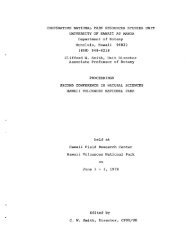american samoa - University of Hawaii at Manoa
american samoa - University of Hawaii at Manoa
american samoa - University of Hawaii at Manoa
Create successful ePaper yourself
Turn your PDF publications into a flip-book with our unique Google optimized e-Paper software.
I. INTRODUCTION<br />
The Geography<br />
Samoa is a volcanic archipelago situ<strong>at</strong>ed in the<br />
south I'acitic Ocean <strong>at</strong> a l<strong>at</strong>itude <strong>of</strong> 13 - 15" south<br />
and a longitude <strong>of</strong> 168 - 173" west, and runs in a<br />
west-northwest direction east <strong>of</strong> Fiji, north <strong>of</strong> Tonga,<br />
south <strong>of</strong> Tokelau, and west <strong>of</strong> Niue and the Cook<br />
Islands (Fig. 1). It comprises nine inhabited<br />
volcanic islands and two distant <strong>at</strong>olls, and has a<br />
total area <strong>of</strong> ca. 3 100 km2. The archipelago is<br />
divided politically into Western Samoa, which is an<br />
independent country, and American Samoa, which is<br />
an unincorpor<strong>at</strong>ed territory <strong>of</strong> the United St<strong>at</strong>es.<br />
American Samoa, which comprises the east end<br />
<strong>of</strong> the archipelago, consists <strong>of</strong> five main volcanic<br />
islands (Tutuila, 'Aunu'u, Ofu, Olosega, and Ta'u)<br />
and two <strong>at</strong>olls (Rose and Swains). Tutuila, on which<br />
this unit <strong>of</strong> the new proposed park is loc<strong>at</strong>ed (other<br />
units are on Ofu and Ta'u), is the westernmost and<br />
by far the largest <strong>of</strong> the islands <strong>of</strong> American Samoa.<br />
It has an area <strong>of</strong> approxim<strong>at</strong>ely 142 km2 and a<br />
maximum elev<strong>at</strong>ion <strong>of</strong> 653 m on top <strong>of</strong> M<strong>at</strong>afao<br />
(Amerson et a/. 1982).<br />
The proposed Tutuila unit <strong>of</strong> the N<strong>at</strong>ional Park <strong>of</strong><br />
American Samoa is loc<strong>at</strong>ed on the north central part<br />
<strong>of</strong> the island, between the villages <strong>of</strong> Fagasa on the<br />
west and Afono on the east (Fig. 2 & 3). The village<br />
<strong>of</strong> V<strong>at</strong>ia is situ<strong>at</strong>ed in the center <strong>of</strong> the park, and the<br />
boundaries around it begin <strong>at</strong> about the 200 ft<br />
elev<strong>at</strong>ional line. The northern boundary is the<br />
I'acific Ocean, and the southern boundary is the<br />
slope leading from Pago Pago Harbor up to Alava<br />
Ridge. The highest elev<strong>at</strong>ion in the Tutuila unit <strong>of</strong><br />
the park is Mt. Alava <strong>at</strong> 490 m (1610 ft), where a<br />
TV tower is loc<strong>at</strong>ed, and the total area <strong>of</strong> the park is<br />
2,770 acres (N<strong>at</strong>ional Park Service 1988). The Ofu<br />
unit is discussed in Appendix D.<br />
The CIim<strong>at</strong>e<br />
Since American Samoa comprises small islands<br />
situ<strong>at</strong>ed between the Tropic <strong>of</strong> Capricorn and the<br />
Equ<strong>at</strong>or, its clim<strong>at</strong>e is maritime and tropical. It<br />
belongs to Koeppen's "tropical clim<strong>at</strong>e zone"<br />
characterized by average monthly temper<strong>at</strong>ures <strong>of</strong><br />
more than 1 8"C, no winter season, and abundant<br />
annual rainfall th<strong>at</strong> exceeds annual evapor<strong>at</strong>ion. The<br />
mean daily temper<strong>at</strong>ure for Tutuila is 26.7"C (80°F),<br />
with an average maximum daily <strong>of</strong> 29.7"C (85.4"F)<br />
and an average minimum daily <strong>of</strong> 23.6"C (74.6"F).<br />
There is not much seasonal vari<strong>at</strong>ion, with the<br />
warmest month being March (27.2"C, 80.9OF) and<br />
the coolest being August (25.9"C, 78.7"F)<br />
(Nakamura 1984).<br />
The rainfall <strong>at</strong> the airport <strong>at</strong> Tafuna on the<br />
south-central coast <strong>of</strong> Tutuila averages about 3200<br />
mm (124 in) per year (Nakamura 1984). The<br />
monthly average there from October to May is 300<br />
mm (12 in), while in the dry season from June to<br />
September it is 180 mm (7 in). This vari<strong>at</strong>ion is<br />
strongly affected by the tradewinds, which blow<br />
regularly from the southeast from about April to<br />
December. The months when they are absent are<br />
characterized by storms coming in from other<br />
directions.<br />
Topographic fe<strong>at</strong>ures strongly effect these totals<br />
in some places. For example, Pago Pago, which lies<br />
just to the west <strong>of</strong> "Rainmaker" (M<strong>at</strong>afao) mountain,<br />
averages nearly 5000 mm (200 in) a year. There is<br />
probably not too much <strong>of</strong> a rainshadow effect, since<br />
the island is not very high in elev<strong>at</strong>ion, but more<br />
rain would be expected to fall on the south and east<br />
coasts than on the north and west coasts, as in<br />
Western Samoa (Wright 1963).<br />
The rel<strong>at</strong>ive humidity is constantly high, ranging<br />
between 82 and 86% (<strong>at</strong> 5 p.m.) throughout the year<br />
(Amerson et al. 1982). Droughts <strong>of</strong> varying dur<strong>at</strong>ion<br />
occasionally occur, but these do not have much<br />
permanent effect on the veget<strong>at</strong>ion. Hurricanes, the<br />
most recent <strong>of</strong> which were in 1987 (known as Tusi),<br />
1990 (Ofa), and 1991 (Val), periodically hit the<br />
islands, but the occurrence <strong>of</strong> three strong hurricanes<br />
in such close proximity is unusual.<br />
The Geology<br />
Samoa is a volcanic archipelago th<strong>at</strong> is "oceanic"<br />
in origin, i.e., it was formed from basalt rising from<br />
a "hot spot" on the ocean floor <strong>of</strong> the Pacific pl<strong>at</strong>e<br />
beyond the continental islands to the west. The<br />
archipelago was born in isol<strong>at</strong>ion, and has never had<br />
a connection to any other land area. The islands<br />
origin<strong>at</strong>ed in the Pliocene Epoch (over two million<br />
years ago), and were formed generally in a westerly<br />
direction, with the youngest on the west end <strong>of</strong> the<br />
chain (Savai'i in Western Samoa) and the oldest on<br />
the east end (Rose Atoll). The most recent volcanic<br />
activity in American Samoa was a submarine<br />
eruption between Ta'u and Olosega in 1866. The<br />
only signs <strong>of</strong> geologically recent volcanism on<br />
Tutuila are the Tafuna Plain, and several adjacent
















